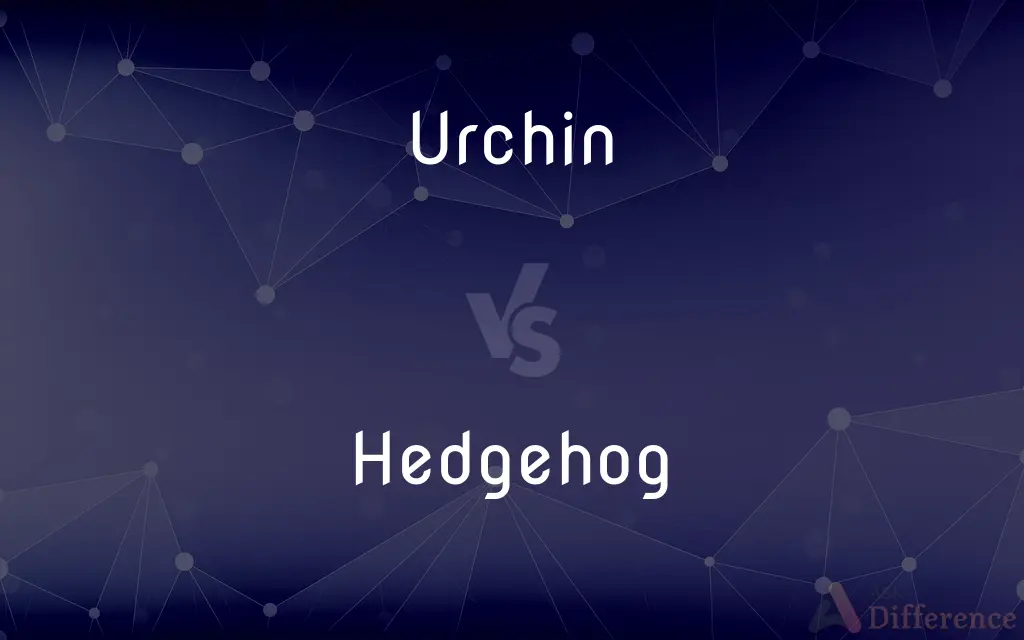Urchin vs. Hedgehog — What's the Difference?
By Fiza Rafique & Maham Liaqat — Updated on April 22, 2024
Urchins are marine animals with spiny exteriors, typically found in oceans, while hedgehogs are small, terrestrial mammals known for their spiky back quills.

Difference Between Urchin and Hedgehog
Table of Contents
ADVERTISEMENT
Key Differences
Urchins, also known as sea urchins, are echinoderms, related to starfish and sand dollars, and inhabit marine environments. They have round, spiny bodies used for protection against predators. On the other hand, hedgehogs are mammals found on land, primarily in Europe, Asia, and Africa, and are characterized by their unique spiny quills, which are modified hairs.
While urchins move slowly across the sea floor using tube feet and spines, hedgehogs are known for their ability to curl into a ball when threatened, using their quills as a defense mechanism. This mobility difference highlights their adaptation to their respective environments—water vs. land.
Urchins primarily feed on algae and small invertebrates, using their strong, beak-like mouthparts located on their underside. Conversely, hedgehogs are insectivores, consuming a diet of insects, worms, and other small creatures, which they hunt on the ground using their sense of smell.
Reproduction differs significantly as well; urchins release sperm and eggs into the water, relying on external fertilization. Hedgehogs, however, have internal fertilization, with the females giving birth to live young, who are initially spineless.
The conservation status of each varies greatly. Many sea urchin species are not threatened, although some are due to overfishing and habitat loss. Hedgehogs, particularly in Europe, face threats from habitat reduction and road accidents, placing some species at risk of decline.
ADVERTISEMENT
Comparison Chart
Type
Marine echinoderms
Terrestrial mammals
Habitat
Oceans
Forests, grasslands, and gardens
Mobility
Move using tube feet and spines
Walk and can curl into a ball
Diet
Algae, small invertebrates
Insects, worms, small creatures
Reproduction
External fertilization
Internal fertilization
Defense Mechanism
Spines for protection
Quills used to curl into a ball
Compare with Definitions
Urchin
A spiny, globular marine animal belonging to the echinoderm class.
The diver photographed a colorful sea urchin nestled in a coral reef.
Hedgehog
Primarily nocturnal and feeds on insects.
At night, you might spot a hedgehog foraging for insects in the garden.
Urchin
Known for their protective spiny covering.
The urchin’s spines are sharp enough to deter most predators.
Hedgehog
Reproduces by giving birth to live young, which are initially spineless.
The hedgehog mother cares for her young until their spines harden.
Urchin
Feeds on algae and small marine organisms.
Sea urchins play a crucial role in controlling algae growth on reefs.
Hedgehog
A small mammal with a coat of stiff, sharp spines.
The hedgehog curled into a ball when it heard the footsteps.
Urchin
Subject to environmental and fishing pressures.
Conservation efforts are increasing to protect urchin populations from overharvesting.
Hedgehog
Capable of curling into a tight ball as a defense against predators.
When threatened, the hedgehog instantly transforms into a spiky ball.
Urchin
Uses tube feet for movement.
The urchin slowly moved across the tank using its tube feet.
Hedgehog
Facing threats from habitat loss and road traffic.
Many hedgehog populations are declining due to urban expansion.
Urchin
A playful or mischievous youngster; a scamp.
Hedgehog
A hedgehog is a spiny mammal of the subfamily Erinaceinae, in the eulipotyphlan family Erinaceidae. There are seventeen species of hedgehog in five genera found throughout parts of Europe, Asia, and Africa, and in New Zealand by introduction.
Urchin
A sea urchin.
Hedgehog
Any of several small insectivorous mammals of the subfamily Erinaceinae, native to Eurasia and Africa and naturalized in New Zealand, having dense erectile spines covering the back and sides and characteristically rolling into a ball for protection.
Urchin
(Archaic) A hedgehog.
Hedgehog
Any of several spiny animals, such as the porcupine, that are similar to the hedgehog.
Urchin
A mischievous child.
Hedgehog
A well fortified military position.
Urchin
A street urchin, a child who lives, or spends most of their time, in the streets.
Hedgehog
An antisubmarine weapon consisting of several rows of mortar-like dischargers positioned to fire in a circular pattern ahead of a ship.
Urchin
A sea urchin.
Hedgehog
An obstacle used against tanks and landing craft, consisting of three crossed iron bars welded or bolted together.
Urchin
One of a pair in a series of small card cylinders arranged around a carding drum; so called from its fancied resemblance to the hedgehog.
Hedgehog
A small mammal, of the family Erinaceidae or subfamily Erinaceinae (pl=s, the latter characterized by their spiny back and often by the habit of rolling up into a ball when attacked.)
Urchin
(historical) A neutron-generating device that triggered the nuclear detonation of the earliest plutonium atomic bombs.
Hedgehog
(US) Any of several spiny mammals, such as the porcupine, that are similar to the hedgehog.
Urchin
(obsolete) A hedgehog.
Hedgehog
(military) Czech hedgehog an antitank obstacle constructed from three steel rails.
Urchin
(obsolete) A mischievous elf supposed sometimes to take the form of a hedgehog.
Hedgehog
A spigot mortar-type of depth charge weapon from World War II that simultaneously fires a number of explosives into the water to create a pattern of underwater explosions intended to attack submerged submarines. Category:en:World War II
Urchin
A hedgehog.
Hedgehog
(Australia) A type of chocolate cake (or slice), somewhat similar to an American brownie.
Urchin
A sea urchin. See Sea urchin.
Hedgehog
A form of dredging machine.
Urchin
A mischievous elf supposed sometimes to take the form a hedgehog.
Hedgehog
Certain flowering plants with parts resembling a member of family Erinaceidae
Urchin
A pert or roguish child; - now commonly used only of a boy.
And the urchins that stand with their thievish eyesForever on watch ran off each with a prize.
You did indeed dissemble, you urchin you; but where's the girl that won't dissemble for an husband?
Hedgehog
Medicago intertexta, the pods of which are armed with short spines.
Urchin
One of a pair in a series of small card cylinders, arranged around a carding drum; - so called from its fancied resemblance to the hedgehog.
Hedgehog
Retzia capensis of South Africa.
Urchin
Rough; pricking; piercing.
Hedgehog
The edible fungus Hydnum repandum.
Urchin
Poor and often mischievous city child
Hedgehog
A kind of electrical transformer with open magnetic circuit, the ends of the iron wire core being turned outward and presenting a bristling appearance.
Hedgehog
A way of serving food at a party, consisting of a half melon or potato etc. with individual cocktail sticks of cheese and pineapple stuck into it.
Hedgehog
(differential geometry) A type of plane curve; see Hedgehog (geometry). Category:en:Curves
Hedgehog
(military) To make use of a hedgehog barricade as a defensive maneuver.
Hedgehog
To array with spiky projections like the quills of a hedgehog.
Hedgehog
(ambitransitive) To curl up into a defensive ball.
Hedgehog
A small European insectivore (Erinaceus Europæus), and other allied species of Asia and Africa, having the hair on the upper part of its body mixed with prickles or spines. It is able to roll itself into a ball so as to present the spines outwardly in every direction. It is nocturnal in its habits, feeding chiefly upon insects.
Hedgehog
The Canadian porcupine.
Hedgehog
A species of Medicago (Medicago intertexta), the pods of which are armed with short spines; - popularly so called.
Hedgehog
A form of dredging machine.
Hedgehog
A variety of transformer with open magnetic circuit, the ends of the iron wire core being turned outward and presenting a bristling appearance, whence the name.
Hedgehog
A defensive obstacle having pointed barbs extending outward, such as one composed of crossed logs with barbed wire wound around them, or a tangle of steel beams embedded in concrete used to impede or damage landing craft on a beach; also, a position well-fortified with such defensive obstacles.
Hedgehog
Relatively large rodents with sharp erectile bristles mingled with the fur
Hedgehog
Small nocturnal Old World mammal covered with both hair and protective spines
Common Curiosities
Are urchins or hedgehogs at risk of extinction?
Some species of urchins are at risk due to overfishing, whereas hedgehogs are threatened by habitat loss and road traffic.
What environments do urchins and hedgehogs live in?
Urchins live in marine environments like oceans, while hedgehogs inhabit terrestrial regions such as forests and grasslands.
What do urchins eat compared to hedgehogs?
Urchins primarily consume algae and small invertebrates, while hedgehogs eat insects, worms, and similar small creatures.
What conservation efforts are in place for hedgehogs?
Conservation efforts include habitat preservation, creating hedgehog-friendly zones in gardens, and awareness campaigns to reduce road deaths.
How do urchins and hedgehogs reproduce?
Urchins reproduce through external fertilization in the water, and hedgehogs use internal fertilization, with females giving birth to live young.
Can urchins move quickly?
No, urchins generally move very slowly using their tube feet and spines.
What is the impact of climate change on sea urchins?
Climate change affects sea urchins by altering their habitats and the availability of their food sources.
Do urchins have any natural predators?
Yes, urchins are preyed upon by several species, including starfish, fish, and humans.
How do urchins and hedgehogs defend themselves?
Urchins use their hard, spiny exteriors to protect against predators, whereas hedgehogs curl into a ball, exposing their spines.
How do hedgehogs contribute to controlling insect populations?
Hedgehogs help control insect populations in their habitats, benefiting agricultural and garden areas by reducing pest numbers.
What is the lifespan of a hedgehog compared to an urchin?
Hedgehogs typically live 4-7 years, while the lifespan of urchins can vary widely depending on the species.
How do hedgehogs hunt for their food?
Hedgehogs use their keen sense of smell to locate insects and other prey during the night.
How do urchins contribute to their ecosystem?
Urchins help control algae populations on reefs, playing a crucial role in maintaining the health of coral ecosystems.
Can hedgehogs be kept as pets?
Yes, hedgehogs can be kept as pets, but they require specific care to ensure their health and wellbeing.
What are common predators of hedgehogs?
Common predators include owls, foxes, and larger birds of prey.
Share Your Discovery

Previous Comparison
Sentiment vs. Logical
Next Comparison
Commonized vs. CommonizeAuthor Spotlight
Written by
Fiza RafiqueFiza Rafique is a skilled content writer at AskDifference.com, where she meticulously refines and enhances written pieces. Drawing from her vast editorial expertise, Fiza ensures clarity, accuracy, and precision in every article. Passionate about language, she continually seeks to elevate the quality of content for readers worldwide.
Co-written by
Maham Liaqat













































